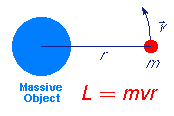Conservation of Angular
Momentum
Our theory for the origin of the Solar System is a very old one with some
modern innovations called the Nebular Hypothesis.
A crucial ingredient in the nebular hypothesis is the conservation of angular
momentum.
Angular Momentum
 Recall that objects executing motion around a point possess angular momentum.
This is an important physical quantity because all experimental
evidence indicates that angular momentum is rigorously conserved in our
Universe: it can be transferred, but it cannot be created or destroyed. For
the simple case of a small mass executing uniform
circular motion around a much larger
mass (so that we can neglect the effect of the center of mass) the amount of
angular momentum takes a simple form. As the adjacent figure illustrates the
magnitude of the angular momentum in this case is L = mvr, where
L is the
angular momentum, m is the mass of the small object,
v is the magnitude of its
velocity, and r is the separation between the
objects.
Recall that objects executing motion around a point possess angular momentum.
This is an important physical quantity because all experimental
evidence indicates that angular momentum is rigorously conserved in our
Universe: it can be transferred, but it cannot be created or destroyed. For
the simple case of a small mass executing uniform
circular motion around a much larger
mass (so that we can neglect the effect of the center of mass) the amount of
angular momentum takes a simple form. As the adjacent figure illustrates the
magnitude of the angular momentum in this case is L = mvr, where
L is the
angular momentum, m is the mass of the small object,
v is the magnitude of its
velocity, and r is the separation between the
objects.
Ice Skaters and Angular Momentum
This formula indicates one
important physical consequence of angular momentum: because the above formula
can be rearranged to give v = L/(mr) and L
is a constant for an isolated
system, the velocity v and the separation r
are inversely correlated. Thus, conservation of angular momentum
demands that a decrease in the separation
r be accompanied by an increase in the velocity v,
and vice versa. This important concept carries over to more complicated
systems: generally, for rotating bodies, if their radii decrease they must
spin faster in order to conserve angular momentum. This concept is familiar
intuitively to the ice skater who spins faster when the arms are drawn in, and
slower when the arms are extended; although most ice skaters don't think about
it explictly, this method of spin control is nothing but an invocation of the
law of angular momentum conservation.
 Recall that objects executing motion around a point possess angular momentum.
This is an important physical quantity because all experimental
evidence indicates that angular momentum is rigorously conserved in our
Universe: it can be transferred, but it cannot be created or destroyed. For
the simple case of a small mass executing uniform
circular motion around a much larger
mass (so that we can neglect the effect of the center of mass) the amount of
angular momentum takes a simple form. As the adjacent figure illustrates the
magnitude of the angular momentum in this case is L = mvr, where
L is the
angular momentum, m is the mass of the small object,
v is the magnitude of its
velocity, and r is the separation between the
objects.
Recall that objects executing motion around a point possess angular momentum.
This is an important physical quantity because all experimental
evidence indicates that angular momentum is rigorously conserved in our
Universe: it can be transferred, but it cannot be created or destroyed. For
the simple case of a small mass executing uniform
circular motion around a much larger
mass (so that we can neglect the effect of the center of mass) the amount of
angular momentum takes a simple form. As the adjacent figure illustrates the
magnitude of the angular momentum in this case is L = mvr, where
L is the
angular momentum, m is the mass of the small object,
v is the magnitude of its
velocity, and r is the separation between the
objects.